Turkish semolina dessert, or Sutlu Irmik Tatlisi, is a delightful treat that blends rich history and flavor. It's easy to make, featuring semolina, sugar, butter, milk, and vanilla, creating a creamy texture. You'll love the added crunch of sugar-coated walnuts on top. Chill it for the perfect consistency, and you're set to impress your guests. This simple yet flavorful dessert captures the essence of Turkish hospitality, and there's much more to discover about its ingredients and variations.
History
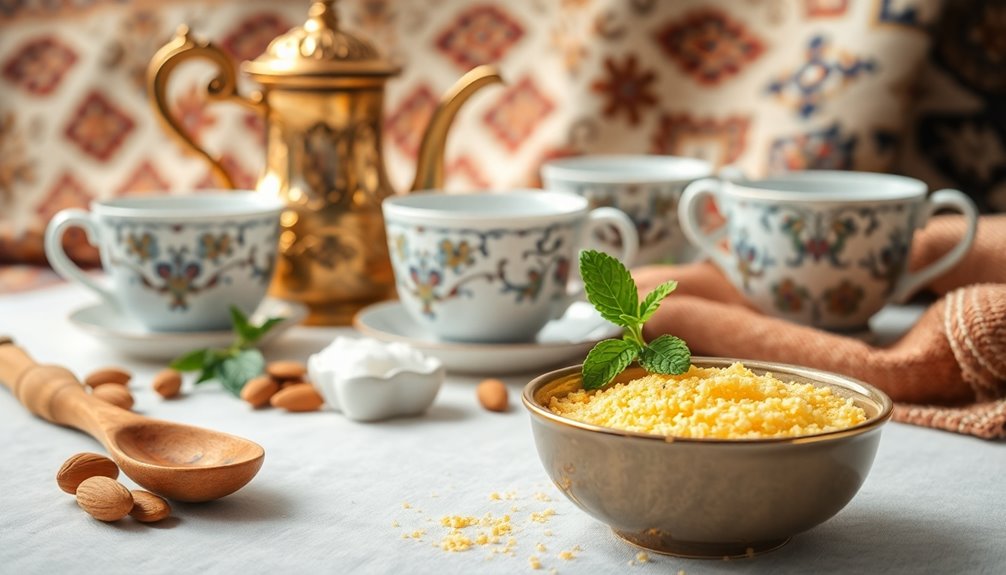
Turkish semolina desserts have a rich history that dates back to the Ottoman Empire, where culinary traditions blended from Europe, Asia, and Africa.
These desserts, like semolina halva and Sutlu Irmik Tatlisi, showcase the versatility of semolina, a staple grain in Turkey for centuries. Its unique texture and flavor absorption make it ideal for creating delightful Turkish desserts. The consumption of raw foods has been linked to various health benefits, much like the nutritious ingredients found in these semolina dishes. In fact, semolina's high fiber content contributes to digestive health, making it a beneficial ingredient in these recipes.
Family recipes play a crucial role in preserving these culinary traditions, often passed down through generations. You'll find sweet semolina dishes served during special occasions, highlighting their importance in Turkish hospitality. Additionally, the use of indigenous ingredients in various cultures, similar to Turkish desserts, reflects a shared appreciation for local flavors and culinary heritage.
Family recipes are vital in keeping Turkish semolina dessert traditions alive, cherished and shared through generations during special occasions.
Variations of these desserts are also present across the Mediterranean and Middle Eastern regions, reflecting a shared culinary heritage that enriches the dining experience.
Recipe
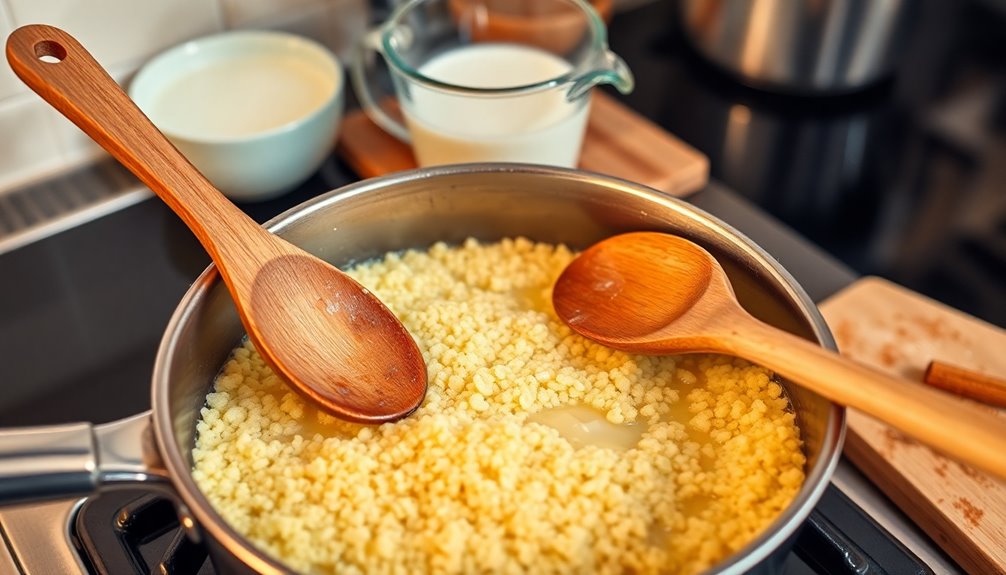
Turkish semolina dessert, known as Sutlu Irmik Tatlisi, is a delightful treat that combines simplicity with rich flavors, making it a favorite among dessert lovers. The creamy texture, complemented by the nutty flavor of semolina, creates a satisfying experience that's perfect for any occasion. This dessert not only captivates the palate but also offers a visual treat, especially when garnished with sugar-coated walnuts that add a delightful crunch. Additionally, it can be enjoyed as a sweet ending after a meal, similar to how Turkey Bean and Tomato Zoodle Bowl serves as a light low-carb option for lunch or dinner. In fact, the appeal of creamy desserts like this one is universal, much like Birthday Cake Ice Cream which also delights a wide audience. Hearing evaluations are essential for ensuring a comprehensive understanding of one's health, just as this dessert is essential for a well-rounded meal experience.
Preparing this dessert is surprisingly quick and easy, requiring only a few basic ingredients that are likely already in your pantry. With minimal cooking time and a chilling period to enhance its flavor, this recipe is perfect for both novice and experienced cooks who want to impress their guests with a delicious and beautiful dessert.
Ingredients:
- 1 cup semolina
- 1 cup sugar
- 1/2 cup butter
- 4 cups milk
- 1 teaspoon vanilla extract
- Sugar-coated walnuts (for garnish)
Instructions:
In a medium saucepan, melt the butter over medium heat. Once melted, add the semolina and sugar, stirring continuously until the mixture becomes golden brown and fragrant.
Gradually pour in the milk while continuously stirring to prevent lumps from forming. Continue to cook the mixture for about 15 minutes, or until it thickens to a pudding-like consistency.
Remove from heat and stir in the vanilla extract. Pour the pudding into serving dishes and allow it to cool at room temperature before refrigerating for at least 30 minutes to set.
Extra Tips:
To elevate the dessert further, consider adding a sprinkle of cinnamon or a drizzle of honey before serving.
If you want to experiment with flavors, try incorporating orange or lemon zest into the mixture for a refreshing citrus twist.
Additionally, be sure to chill the dessert adequately to ensure a smooth texture; this step is crucial for achieving the perfect consistency.
Enjoy the sweet crunch of sugar-coated walnuts as a garnish, which not only enhances the taste but also adds a beautiful presentation to your Turkish semolina dessert.
Cooking Steps

To kick off the cooking steps for your Turkish semolina dessert, start by preheating your oven to 350°F.
Next, mix the semolina with sugar before adding yogurt and whisking it all together. Incorporating carrier oils into your cooking can enhance flavors and provide health benefits. Freshly squeezed juices, such as orange juice, can also complement desserts with their natural sweetness.
Finally, gently fold in the whipped egg whites and pour the batter into your prepared pan. Additionally, consider using essential oils to enhance your overall cooking experience by infusing your kitchen with delightful scents.
Step 1. Preheat the Oven to 350°F

Preheating your oven to 350°F (175°C) is a crucial first step in making the perfect semolina dessert. This temperature ensures even baking, allowing your dessert to achieve that desired golden color on both the top and bottom surfaces.
Take about 10-15 minutes to preheat your oven; this helps save time during the baking process. It's a good idea to use an oven thermometer to confirm the temperature is accurate, as different ovens can vary in their actual heat output.
Once the oven reaches 350°F, avoid opening the door frequently while baking. This way, you maintain consistent heat for optimal results, ensuring your semolina dessert turns out just right. Additionally, ensuring color accuracy during the baking process can enhance the final presentation of your dessert.
Happy baking!
Step 2. Mix Semolina and Sugar
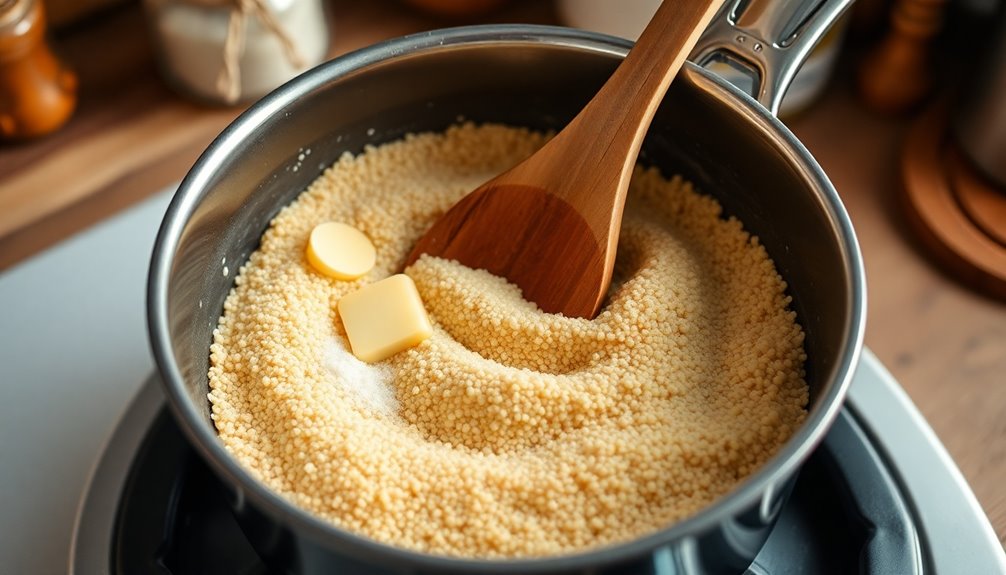
Once your oven is preheated and ready, it's time to focus on mixing the semolina and sugar.
Start by measuring out 1 part semolina to 1.5 parts granulated sugar for a sweet balance, key to this semolina halva recipe. In a mixing bowl, combine the basic ingredients thoroughly with a spatula to ensure even distribution.
If you're preparing a dessert like sambali, let the mixture sit for about an hour to enhance texture.
When cooking, gradually add the semolina and sugar mixture to melted butter or vegetable oil over low heat, stirring continuously to prevent clumping.
Monitor closely, as this process typically takes 3 to 5 minutes for your delicious dessert mixture to thicken properly.
Step 3. Add Yogurt and Whisk Well
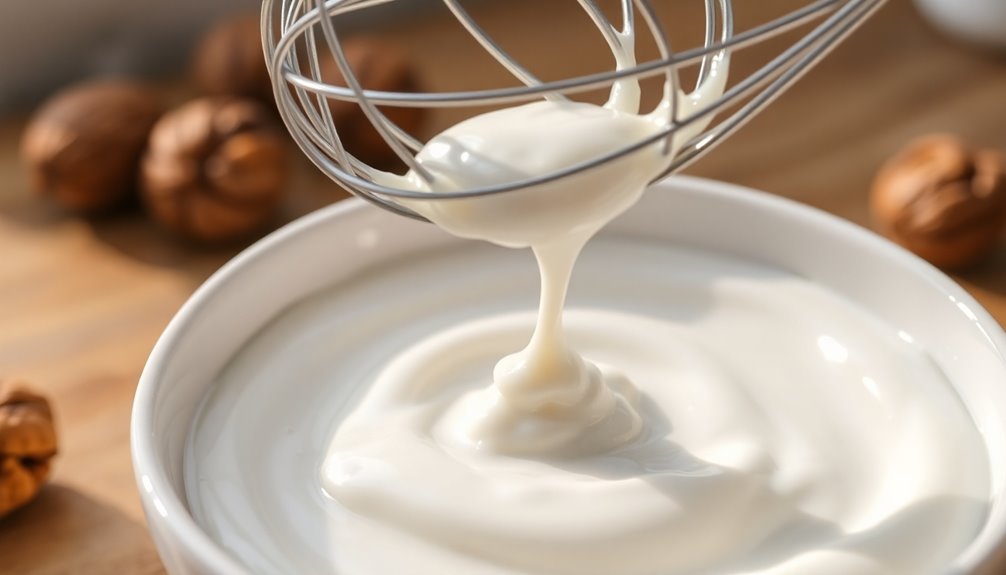
Incorporate the yogurt into your semolina mixture to elevate its creaminess and flavor. Use plain yogurt at room temperature to ensure it blends seamlessly, creating a delicious recipe.
Before adding it, whisk the yogurt well to achieve a uniform consistency and prevent lumps. This step is crucial for a smooth and creamy texture in your Turkish Semolina Halva.
Gently incorporate the yogurt into the mixture to maintain airiness; vigorous mixing can deflate the batter. The tanginess of the yogurt will help balance the sweetness of the dessert, enhancing the overall taste.
Step 4. Fold in Whipped Egg Whites
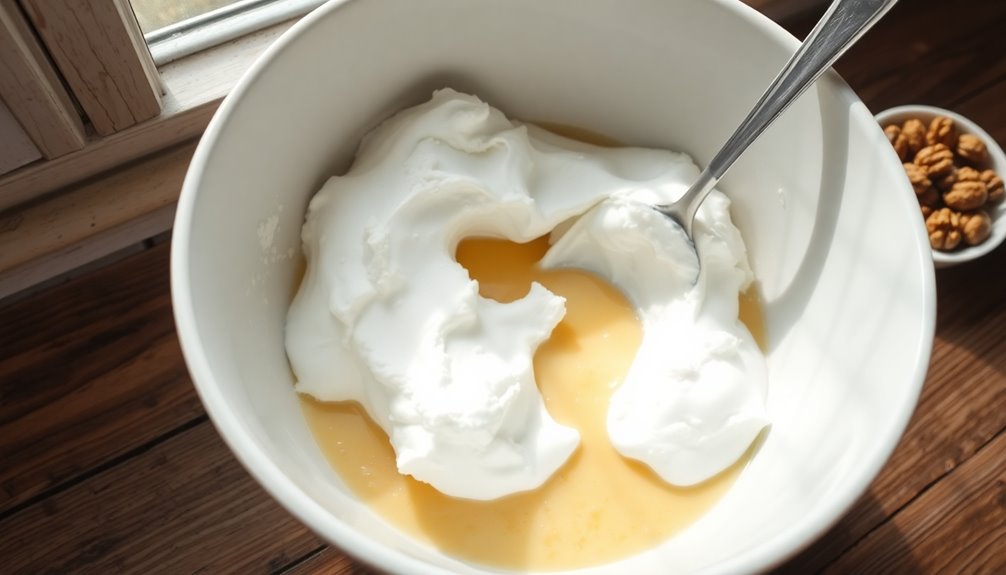
Gently fold in the whipped egg whites to your semolina mixture for a light and airy texture.
Start by ensuring your egg whites are whipped to stiff peaks; they should hold their shape when lifted from the bowl.
Using a rubber spatula, carefully lift and turn the whipped egg whites into the semolina mixture, taking care not to overmix.
Begin with a small amount of egg whites to lighten the base before gradually folding in the remaining whites in two more additions.
This technique helps achieve a fluffy texture and maintains a delicate balance of flavors and moisture in your semolina dessert.
Enjoy the transformation as your mixture becomes wonderfully airy and inviting!
Step 5. Pour Batter Into Prepared Pan
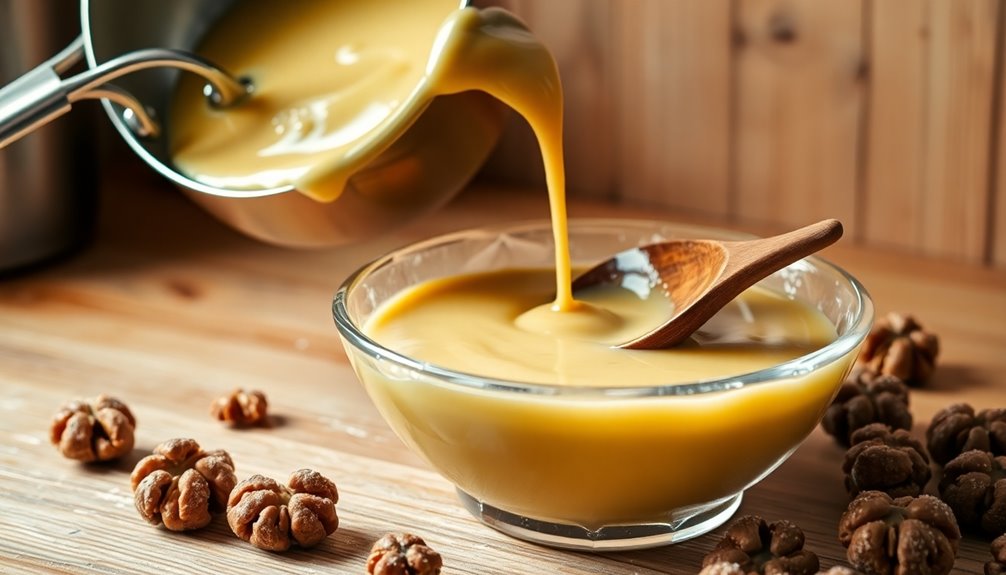
Carefully pour the semolina batter into your prepared pan, ensuring it's evenly distributed for consistent baking.
Make sure your pan is greased and lined with parchment paper to prevent sticking. Once you've poured the batter, use a spatula to gently spread it for uniform baking.
To achieve a smoother texture, bang the pan lightly on the countertop to release air bubbles that may have formed. Remember not to overfill the pan; this allows room for rising during baking.
After you've done this, let the batter rest for about 1 hour. This resting period helps the semolina flour absorb the milk, improving the final texture of your Turkish semolina dessert.
Now you're ready to bake!
Final Thoughts

Savoring the delightful simplicity of Turkish semolina desserts brings a sense of comfort and satisfaction.
This traditional Turkish recipe, featuring creamy semolina, sugar, butter, milk, and vanilla, is easy to make and perfect for beginner cooks. In just 5 minutes of prep and 15 minutes of cooking, you can create a delicious pudding that's garnished with sugar-coated walnuts for added texture.
After chilling for at least 30 minutes, this wonderful dessert is ready to impress. With about 363 kcal per serving, it's indulgent yet manageable in moderation.
Don't forget, any leftovers can be stored in an airtight container, ensuring you enjoy this delightful treat again later. Treat yourself to the rich flavors of Turkish semolina desserts today!
Frequently Asked Questions
What Is Turkey's Most Popular Dessert?
When you think of Turkey's most popular dessert, imagine golden layers of flaky pastry contrasting with rich, sweet syrup.
That's baklava! This delightful treat, filled with nuts and often spiced with cinnamon, is a must-try.
You'll find it cut into elegant diamond shapes, perfect for sharing during special occasions.
Pair it with a cup of Turkish coffee, and you're in for a true taste of Turkish culture that'll leave your taste buds dancing.
What Is Semolina in Turkey?
In Turkey, semolina, known as "irmik," is a coarse flour made from durum wheat.
You'll find it commonly used in various dishes, both sweet and savory. Its unique texture allows it to absorb liquids well, enhancing flavors in your recipes.
Semolina's versatility makes it a staple in Turkish cooking, whether you're whipping up a comforting pudding or experimenting with savory meals.
It's been a beloved ingredient in Turkish cuisine for centuries.
What Is the Difference Between Basbousa and Revani?
Did you know that over 80% of Middle Eastern desserts are syrup-soaked?
When you compare basbousa and revani, you'll notice some key differences. Basbousa is denser and usually flavored with rose water or coconut, while revani is lighter and often boasts a refreshing citrus syrup.
You'll also find that basbousa is often topped with nuts, whereas revani may be dusted with powdered sugar or coconut flakes, showcasing their regional flavors and textures.
Is Semolina Dessert Healthy?
When you consider whether semolina dessert is healthy, it depends on how you prepare it.
It's a source of carbohydrates, offering energy, and contains protein for muscle health. Though lower in fiber, it still contributes to digestive health.
With around 363 calories per serving, it's moderate if you watch your portions.
You can make it healthier by using plant-based milk and reducing sugar, fitting various dietary preferences.









